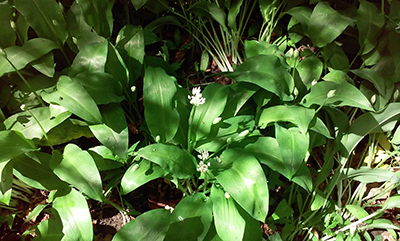Allium ursinum L. (Alliaceae)



| ENG | Ramsons, bear’s garlic |
| SK | Cesnak medvedí |
| CZ | Česnek medvědí |
| PL | Czosnek niedźwiedzi |
| HU |
Using
Beneficial addition to the diet, promoting the general health of the body when used regularly. It is effective in reducing high blood pressure and blood cholesterol level. Plants have anthelmintic, antiasthmatic, antispasmodic, diuretic, diaphoretic, anticarcinogenic actions, they enhance antibiotic therapies. Bear‘s garlic plants reduce blood glucose levels, ease stomach pain and are tonic to the digestion.
| I. | II. | III. | IV. | V. | VI. | VII. | VIII. | IX. | X. | XI. | XII. | |||||||||||||
| Sowing | ||||||||||||||||||||||||
| Planting | ||||||||||||||||||||||||
| Harvest | ||||||||||||||||||||||||
Botanical description and occurrence:
Allium ursinum is a bulbous, perennial herbaceous monocot, commonly knows as bear’s garlic or ramsoms. The narrow bulbs are formed from a single leaf base, bulbs are in clumps, leaves are entire green, elliptical, up to 25 cm. The inflorescence is an umbel of white flowers produce capsules with seeds, but lacking the bulbils. Bear’s garlic is propagated from seeds (own seeds, after stratification, can be sown in July, shop-purchased seeds in October-November, better way is to propagate plants from the bulbs, which can be planted in early autumn). Plants con¬tain many bioactive compounds (flavonoids, vitamin C and E), mineral constituents, and a large number of sulfur derivatives: di¬vinyl sulfide, dim¬ethyl thio¬sulfonate, methyl cystein sulf¬oxide and the latter’s de¬gra¬da¬tion products, methyl allyl thio¬sulfonate and methanethiol. It is native to temperate regions of Europe, from Britain east to the Caucasus.
Why to have the plant in your garden:
Bear’s garlic is a plant valued primarily due to its pro-healthy benefits and taste. The leaves contain significant amounts of vitamin C and can be added to soups, sauces, salads and marinates. In the garden, plants can successfully grow under the canopy of trees and large shrubs. It can be grown well in containers.
Text:
Dr. Andrzej Kalisz, University of Agriculture in Krakow, Poland
Photo:
Dr. Elżbieta Jędrszczyk, University of Agriculture in Krakow, Poland

